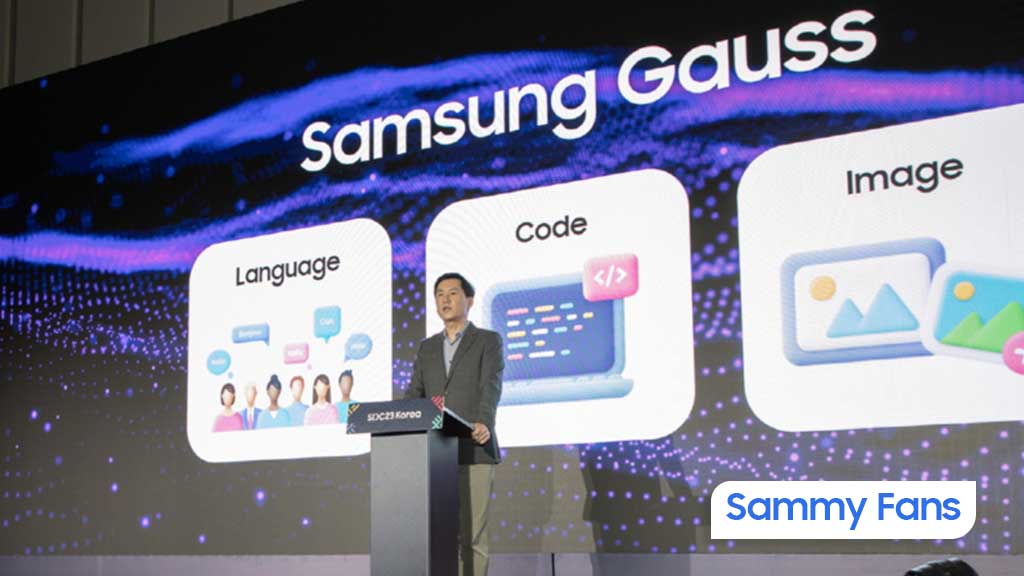AI
Samsung Reveals What Its Gauss AI Model (Language, Code and Image) Can Do!

On November 8, Samsung launched its own-developed Gauss AI model. Moving ahead, the company has now demonstrated the AI model at SDC Korea 2023. At the event, Samsung explained Gauss AI, which includes three models: Language, Code, and Image.
Follow our socials → Google News | Telegram | X/Twitter | Facebook | WhatsApp
Gauss Language
Samsung Gauss Language model learns a language model through massive training data, allowing the selection of a language model of an optimal size for various situations. Apart from Korean, it supports English, French, Spanish, Chinese, and Japanese.

Gauss Image
Samsung Gauss Image model was learned from safe data that does not infringe on licenses or personal information and is designed to operate on-device, so it has the advantage of preventing user information from being leaked to the outside.
The South Korean tech giant has also discussed the Gauss Code in depth, delivering productivity improvement in in-house software development. In addition, the keynote included presentations on Samsung product advanced research technology and customer experience improvement, including:
- Knowledge graph-based data intelligence
- Mobile Galaxy UI features and advantages
- Development direction of the Tizen platform
- Enhancing the connection experience of Tizen-based screen products

// Samsung
AI
Apple Intelligence: A Disappointment for Old iPhone Owners

Apple Intelligence is Apple’s entrance into generative AI and large language models (LLMs), offering intriguing features but a limited availability and slow rollout pace appear to be a disappointment to existing and new iPhone owners.
At WWDC24, Apple introduces this new AI suit for iPhones, iPads, and Mac devices. Compared to iPhones, iPad and Mac devices can run Apple Intelligence in up to four-year-old models.
Meanwhile, only the iPhone 15 Pro and 15 Pro Max can run Apple Intelligence. That’s it, other devices including the standard iPhone 15 or the Plus are also ineligible.
The iPhone maker gave a brief reason behind for leftover. Devices other than 15 Pros cannot run new LLMs due to insufficient computational power.
Computational power refers to the ability to process information (datasets and complex requests) in real time. This segment relies on the device’s chipset. It means, previous iPhones might run Apple Intelligence but are likely to perform slower than eligible devices.
These explanations for computational requirements make sense but are not “completely” true for previous iPhones.

Apple Intelligence (Source – Apple)
M1 vs A14 Bionic – Both are the same but only one is compatible
M1 chipset from 2020 is compatible with Apple Intelligence. It is the first Apple silicon and marked the transition from the Intel chipset. The chip has a 16-core NPU architecture capable of completing 11 trillion operations per second.
A14 Bionic, released with iPhone 12 models also has a 16-core Neural engine and completes 11 trillion operations per second but it’s incompatible with Apple’s AI.
Neural engine is responsible for AI and trillion operations are the backbone of on-device AI. These are the core concepts of Apple Intelligence. Besides, it is also using server-side compute to support powerful features.
Looking at successors, the iPhone 13 series launched in 2021 has A15 Bionic with a 16-core Neural engine. It can process 15.8 trillion operations per second. In the following year, A16 brought the same architecture with 17 trillion operations per second.
The latest A17 Pro chipset used in iPhone 15 Pro and Pro Max brings 16-core architecture with 35 trillion operations per second. That’s twice the speed of the A16.
While the A17 Pro has a much faster Neural engine, the A14 is still comparable to M1 in architecture and computational power. It makes the processor eligible for Apple Intelligence.
RAM – A key factor?
Some might argue that the ineligibility lies in onboard RAM, which is 8GB in iPhone 15 Pro models. On the other hand, iPhone 15 and old models have only 6GB RAM.
Apple’s RAM angle has caused much discussion in the smartphone industry. The company doesn’t reveal actual RAM capacity, which is highly questionable.
Interestingly, this low-RAM practice remained in action until last year, while Samsung has been using at least 12GB and more RAM in its flagship devices since 2020.
If we look at this aspect, this fault is still under Apple’s account because consumers have entrusted the brand with thousands of dollars per device. Therefore, these specs should have been compatible enough to support future major upgrades.
Apple Should Try
Over the past years, millions of consumers purchased iPhones but only two received Apple Intelligence.
If we look at this compatibility angle, even though some of the newest features might not completely run on old devices, Apple might have ported a few AI capabilities.
For example, the company could’ve opted for on-device computational capability in these existing iPhones if it didn’t want to go full-fledged with server-side computing. However, there isn’t the slightest effort made in this direction.
Moreover, the A16 bionic chipset used in the iPhone 15 and 15 Plus has left its user base behind in the AI race while launching alongside the iPhone 15 Pros. Now, these iPhones are ineligible in Apple’s generative AI dictionary.
New Devices – Empty Promotion
The story doesn’t end here, iPhone 16 series users are also part of this AI promotion. During the September 9 launch event, top Apple executives promoted all Apple Intelligence features for this lineup.
In reality, Apple Intelligence doesn’t ship with these iPhones out of the box. Instead, Apple is sending these in batches with an incremental over-the-air software update rollout.
iPhone 16 owners have only received the first batch of Apple Intelligence with iOS 18.1 and waiting for the iOS 18.2 release in December with additional generative AI image features.
Still, an advanced Siri voice assistant is missing in action and not expected to rollout until next year.
Apple Intelligence Disappointment
Generative AI and LLMs can greatly improve smartphone user experience and limiting previous devices from Apple Intelligence capabilities is a big disappointment for consumers.
AI
AI and 6G: Insights from Samsung Silicon Valley Future Wireless Summit
On November 6, Samsung held the Silicon Valley Future Wireless Summit in Mountain View, California. The theme of the event was “Future Wireless for the AI Era.”
Around 80 experts from telecommunications operators, manufacturers, government agencies, and academia came together to talk about the future of communication technology, especially how artificial intelligence (AI) can play a role.
The summit followed the announcement of new 5G-Advanced standards by the 3rd Generation Partnership Project (3GPP) in March. This has led to increased interest in how AI can be used in telecommunications as the industry gets ready for 6G.
![]()
Angelo Jeongho Park, Vice President of Samsung Research, highlighted that since the introduction of 5G, the focus has shifted toward improving user experience and using innovative technologies like AI and energy-efficient advancements.
Further, he noted that the Samsung Future Wireless Summit summit aims to encourage cooperation between industry and academic leaders on combining AI with wireless technology to make the user experience even better.
The summit featured a keynote presentation on next-generation mobile communication and three main discussion sessions, including “AI-Native Communication,” “Sustainability: Energy Saving & Efficiency,” and “Innovations to Drive Future Wireless.” Each session included panel discussions which allowed participants to ask questions and share ideas.
![]()
A key point for the demonstration session is AI radio access network (RAN) technology, which Samsung developed with partners. This technology shows how AI can improve the performance of mobile networks.
Samsung is regularly working on shaping the future of communication. It is a founding member of the AI-RAN Alliance and holds leadership roles in several groups working on 6G standards. The company is committed to advancing AI-driven communication technologies to enhance user experiences worldwide.
Samsung launches next-gen Bixby for Galaxy that you could get with One UI 7
AI
iOS 18.1 brings Apple Intelligence—Game on, Galaxy AI!

iOS 18.1 has started rolling out, bringing the first batch to Apple Intelligence features. iPhone 15 Pro and iPhone 16 series models are eligible for AI tricks. iOS 18.1 is set to rival Samsung’s Galaxy AI with Apple Intelligence in the market.
Although the full version of Apple Intelligence may take some time to launch, some features are now available, including Smart Reply, Smart Summary, and writing tools that can proofread, summarize, and rewrite text across the OS.
iOS 18.1 will be available for iPhone models supporting iOS 18, including all iPhones from the iPhone XS and iPhone XR up to the current iPhone 16 models.
Apple’s iOS 18.1 supports spatial photo capture for the iPhone 15 Pro and iPhone 15 Pro Max and adds the existing spatial video capture feature in the new Spatial Camera mode.
Adding to this, new connectivity controls for Satellite and AirDrop have been added to the Control Center, allowing these buttons to be added individually.
Call Recording: iOS 18.1 makes it possible to record phone calls on your iPhone. However, it will notify the second party via announcement that the call is being recorded.
Samsung has been supporting the Call Recording feature on Galaxy devices. Its availability varies by market, but it’s quite useful if used positively as it doesn’t announce call recording notifications.
Samsung vs Apple – AI Distribution
Samsung debuted Galaxy AI with the S24 series earlier this year. Apple announced AI-powered Siri and some other features at this year’s Developer Conference. Samsung’s AI expansion is taking place rapidly, while Apple’s lagging badly.
Mid-range Galaxy users received some AI features like Circle to Search. At the same time, Apple is keeping its Apple Intelligence feature suite limited to Pro models of the iPhone 15 series apart from the recently released iPhone 16 lineup.












